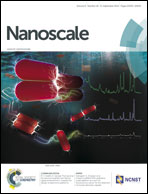Hybrid inverse opals for regulating cell adhesion and orientation
Abstract
Cell adhesion and alignment are two important considerations in tissue engineering applications as they can regulate the subsequent cell proliferation activity and differentiation program. Although many effects have been applied to regulate the adhesion or alignment of cells by using physical and chemical methods, it is still a challenge to regulate these cell behaviors simultaneously. Here, we present novel substrates with tunable nanoscale patterned structures for regulating the adhesion and alignment of cells. The substrates with different degrees of pattern orientation were achieved by customizing the amount of stretching applied to polymer inverse opal films. Cells cultured on these substrates showed an adjustable morphology and alignment. Moreover, soft hydrogels, which have poor plasticity and are difficult to cast into patterned structures, were applied to infiltrate the inverse opal structure. We demonstrated that the adhesion ratio of cells could be regulated by these hybrid substrates, as well as adjusting the cell morphology and alignment. These features of functional inverse opal substrates make them suitable for important applications in tissue engineering.


 Please wait while we load your content...
Please wait while we load your content...